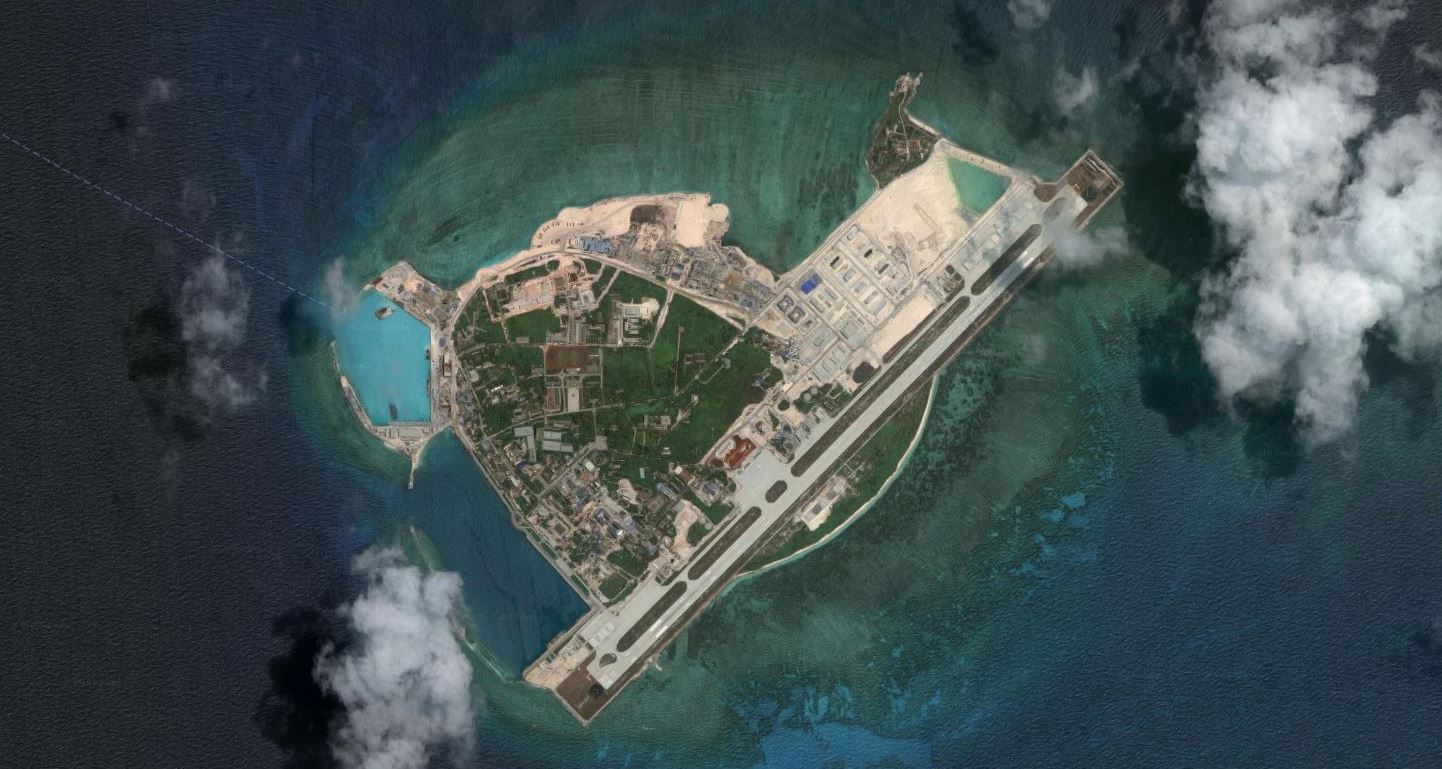This article was originally published by Radio Free Asia and is reprinted with permission.
Even as the coronavirus crisis sweeps through Asia, China continues to assert its presence in the South China Sea by deploying maritime militia around disputed islands and reefs in the Spratly island chain, according to vessel tracking data and satellite imagery reviewed by Radio Free Asia.
A fleet of Chinese ships has been moving this month through the Union Banks, a collection of small land features disputed between China, Malaysia, the Philippines, Vietnam and Taiwan. Among the most significant features in this area are the Chinese-controlled Hughes Reef and Johnson Reef, and Vietnam’s Sin Cowe Island and Collins Reef. These ships were identified as part of China’s infamous maritime militia by the Asia Maritime Transparency Initiative in January 2019.

China’s military base on Woody Island in the South China Sea. (Google Maps/Released)
The five ships whose movements could be tracked by RFA are now at Johnson Reef, in the southwest corner of Union Banks. It may not be a coincidence that that their presence at that location comes within days of the 32nd anniversary of the Battle of Johnson Reef, a March 14, 1988, naval skirmish between Vietnam and China in which dozens of Vietnamese troops died and China seized control of the reef.
As usual, China has not publicized any build-up of its ships around Union Bank. The People’s Armed Forces Maritime Militia (PAFMM) often consists of what are ostensibly fishing vessels – although they do not engage in fishing. Their presence is meant to ‘fly the flag’ for Beijing in disputed waters without an overt display of military force that would draw international condemnation.

The littoral combat ship USS Fort Worth (LCS 3) conducts patrols in international waters of the South China Sea near the Spratly Islands, in 2015. (U.S. Navy photo by Mass Communication Specialist 2nd Class Conor Minto/Released)
Zack Cooper, a research fellow specializing on Asian security issues at the American Enterprise Institute, said China was continuing with its assertive behavior in regional disputes despite the COVID-19 pandemic now commanding the world’s attention.
“Beijing has stepped up military activity around Taiwan and now appears to be doing some of the same around Union Banks. Whether this is simply a continuation of previous activity or an intentional effort to use this distraction to put pressure on other claimants is unclear,” Cooper said.

South China Sea claims map
(Voice of America/WikiCommons)
Ship-tracking software indicates that five PAFMM vessels – with the call signs Yuetaiyu (Fishing vessel) 18777, 18333, 18888, 18222, and 18555 — passed in early March between China’s reclaimed island at Subi Reef — often a waystation for Chinese ships deployed to the region — and Thitu Island, a Philippine-occupied feature where Chinese vessels have engaged in a sustained pressure campaign, as documented by the Asia Maritime Transparency Initiative. The ships first stopped at Whitson Reef, in Union Banks’ northeast, from March 3 to March 8.
Then, the vessels moved southwest to Chinese-controlled Hughes Reef, passing by Vietnamese-controlled Sin Cowe East Island (referred to by Vietnam as Sinh Ton Dong), and further west near Sin Cowe Island (Sinh Ton). The ships lingered near Sin Cowe between March 13 and March 18.
The exact number of Chinese ships deployed to the area very likely exceeds the five detected by RFA using ship-tracking software. Satellite imagery reveals many more vessels gathered in Union Banks although the identity of the vessels is unclear. About 12 ships moved to Hughes Reef between March 8 and March 13.
Additionally, dozens of other ships have been lingering in the northeastern point of Union Banks, inside Whitson Reef, since at least March 6 and were still in the area as of March 19. Whitson is a shallow coral reef, which hosts no artificial islands or facilities. Satellite imagery reveals large clusters of vessels banded together.
The Yuetaiyu-series vessels that had been at Chinese-held Hughes Reef and then the Vietnamese controlled Sin Cowe islands, moved to China’s Johnson Reef on March 18. Again, satellite imagery shows far more ships in the area than the five broadcasting an AIS, or Automatic Identification System, signal. All ships are required to have an AIS transponder to assist in tracking for search-and-rescue contingencies as well as for law enforcement purposes. Frequently, though, Chinese maritime militia ships simply turn their AIS transponders off to mask their activity. This has clearly been the case this time, as satellite imagery shows at least 30 vessels just at Johnson Reef.
Johnson Reef is a rock, according to the 2016 ruling by the United Nations’ tribunal on China’s claims in the South China Sea. Under the United Nations Convention on the Law of the Sea, a rock is stated plainly as a feature “which cannot sustain human habitation or economic life of their own,” and as such has no rights to an exclusive economic zone or a continental shelf on the seabed. Regardless, it has been built up by China into another artificial island it can use as a base.
As of March 23, the PAFMM ships have moved once again to the same spot near Sin Cowe Island they were at on March 13.



